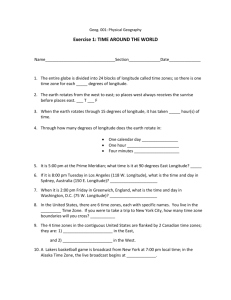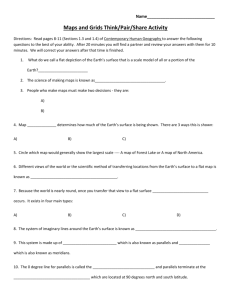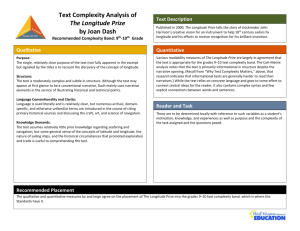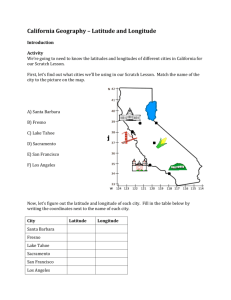Time and longitude
advertisement
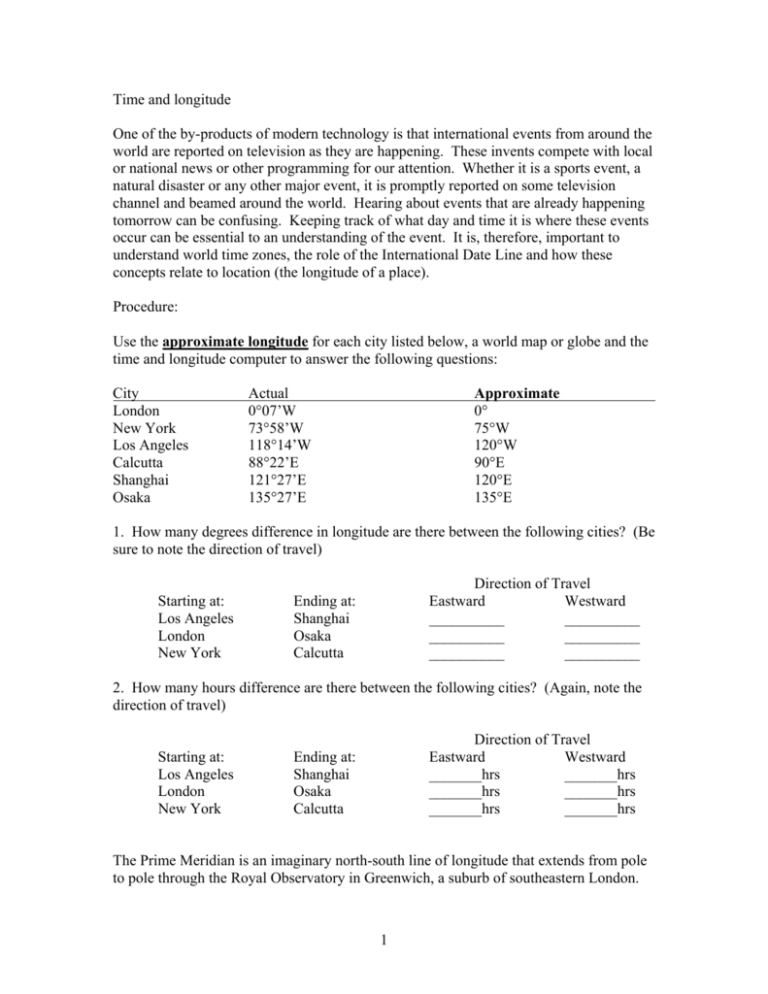
Time and longitude One of the by-products of modern technology is that international events from around the world are reported on television as they are happening. These invents compete with local or national news or other programming for our attention. Whether it is a sports event, a natural disaster or any other major event, it is promptly reported on some television channel and beamed around the world. Hearing about events that are already happening tomorrow can be confusing. Keeping track of what day and time it is where these events occur can be essential to an understanding of the event. It is, therefore, important to understand world time zones, the role of the International Date Line and how these concepts relate to location (the longitude of a place). Procedure: Use the approximate longitude for each city listed below, a world map or globe and the time and longitude computer to answer the following questions: City London New York Los Angeles Calcutta Shanghai Osaka Actual 0°07’W 73°58’W 118°14’W 88°22’E 121°27’E 135°27’E Approximate 0° 75°W 120°W 90°E 120°E 135°E 1. How many degrees difference in longitude are there between the following cities? (Be sure to note the direction of travel) Starting at: Los Angeles London New York Direction of Travel Eastward Westward __________ __________ __________ __________ __________ __________ Ending at: Shanghai Osaka Calcutta 2. How many hours difference are there between the following cities? (Again, note the direction of travel) Starting at: Los Angeles London New York Direction of Travel Eastward Westward _______hrs _______hrs _______hrs _______hrs _______hrs _______hrs Ending at: Shanghai Osaka Calcutta The Prime Meridian is an imaginary north-south line of longitude that extends from pole to pole through the Royal Observatory in Greenwich, a suburb of southeastern London. 1 Distances are measured from zero to 180° west of the Prime Meridian and from zero to 180° east. Opposite the Prime Meridian on the globe is the International Date Line, where the date changes, and where each new day begins. The International Date Line follows the 180° meridian for much of its length, with some deviations for political units. Use the Time and Longitude Computer for the following questions. To use the Time and Longitude Computer, attach the smaller, longitude dial to the larger, time dial using a brass tab (be sure to align the crosses in the center of the two dials). Then spin the inner dial so that a desired longitude aligns with a given time on the outer dial (ideally, the longitude lines and the lines on the time dial should match up exactly – move the inner dial slightly so that they do). Now (without moving the dials) read the time at any other longitude value (your answer will always be a whole hour). Note that there are two (2) locations on the Time and Longitude Computer where the day of the week changes – Midnight and at the International Date Line. When moving clockwise across midnight, the day always goes back (For Example: You move from 1:00 AM on Saturday to 11:00 PM on Friday). Conversely, when moving counter-clockwise across midnight, the day always goes forward. Arrows on the longitude dial tell you whether to advance or go back a day when crossing the International Date Line. At MOST, there can be only TWO DAYS on the Earth at any given time – NEVER any more than that. Every day there is one instant in which there is only ONE day on the Earth. 3. If it is 12:00 noon on Monday in Los Angeles (120°W): What is the time of day in Osaka (135°E)? What is the day of the week in Osaka (135°E)? What is the longitude of midnight? Monday covers how many degrees of longitude? Tuesday covers how many degrees of longitude? __________ __________ __________ __________ __________ 4. If it is 8:00 AM on Saturday in Shanghai (120°E): What is the time of day in Los Angeles (120°W)? What is the day of the week in Los Angeles (120°W)? What is the longitude of midnight? Friday covers how many degrees of longitude? Saturday covers how many degrees of longitude? __________ __________ __________ __________ __________ __________ 5. If it is 6:00 PM on Thursday in Calcutta (90°E): What is the time of day in Los Angeles (120°W)? What is the day of the week in Los Angeles (120°)? What is the longitude of midnight? Thursday covers how many degrees of longitude? Wednesday covers how many degrees of longitude? __________ __________ __________ __________ __________ Do not use the Time and Longitude Computer for the following questions. 2 6. If two places are separated by 0° of latitude and 90° of longitude, how many hours of time separate these two places? 7. If two places are separated by 45° of latitude and 0° of longitude, how many hours of time separate these two places? 8. If each hour to time is equal to 15° of longitude, what portion of a degree of longitude is equal to one (1) second of time? 9. At the equator, how far (in miles) does one travel in five (5) minutes of time, due to the rotation of the Earth? (Hint: Look for the circumference of the Earth in your text or lecture notes). 3
